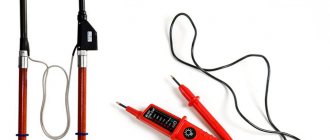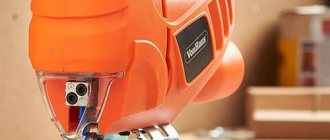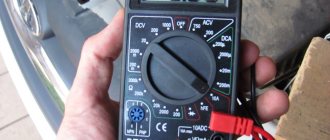The indicator screwdriver, despite its simplicity, is a functional tool. It is used with equal success by professional electricians and people far from this field. Using the device, they determine the polarity of the battery, find a breakdown of electrical wiring in the wall, check the voltage on a hidden cable, determine the phase and neutral wires at the connection point of a key switch, household appliances, and eliminate the risk of overheating and failure of equipment from improper installation.
Types and design of indicator screwdrivers
The tester includes a metal tip that acts as a conductor and a resistor that converts electricity to a safe value. The indicating element in the electrical circuit of a screwdriver is a neon light bulb or LED, which is installed after the resistor. The indicator is connected to a conductive contact on the end or body of the handle.
The operating principle of the probe is simple. The tip of the device is applied to the wire, the current, if it is a phase, passes through the tester, a resistor (resistance) to a lamp or diode, and then to the ground. When working with the device, a person acts as a grounding element. When current passes through the resistor, its value drops to safe values, the user does not feel when the current passes through the body.
This design is the basis for the simplest and most universal tester models. There are several types of indicator screwdrivers:
Simple
A working electrical circuit is installed in the case, with a standard set of elements: transistor, resistor, indicator - neon bulbs. The zero phase is the person who closes the contact plate. The tool is not functional - it detects the voltage on the wire, but often does not work when the network voltage is less than 60 Volts. Not suitable for searching for network breaks.
With LEDs
The models have design and functional differences from the primitive model. An LED is installed as an indicator, allowing you to check the circuit at a voltage not exceeding 60 Volts. Probes of this type contain a bipolar transistor and batteries, which make it possible to perform contactless testing. LED probes are suitable for determining breaks in an electrical circuit and testing electrical equipment circuits.
Universal
Portable devices with a wide range of capabilities. An instrument of this type performs contact and non-contact testing, determines open circuits and short circuits using “ringing” of networks, and light and sound warnings help with this. Universal probes are used when repairing or setting up electronic devices and vehicles; they are designed to work with direct and alternating current. The tester operates on a battery, the charge of which is monitored. If the battery loses charge, the universal screwdriver will not work.
The type of indicator screwdriver is selected depending on the intended work. For everyday use, a simple model is sufficient, but for working with electronic devices, choose a universal device.
Principle of operation
The design of the tester screwdriver includes a resistor and a metal tip. The latter is necessary to supply electricity to the instrument from the wire under test, and the resistor converts the current parameters . In the circuit, as an indicating element after the resistor, there is an LED or neon light bulb, which is connected at the end of the handle to a conductive patch.
The operating principle is simple. The tip of the screwdriver (probe) must be applied to the powered contact , and on the handle a finger is applied to the patch. This results in a closed circuit finger-LED-resistor, through which the passage of the converted current leads to the glow of the neon light bulb.
Where can I buy
To purchase a screwdriver as quickly as possible, you can visit your nearest specialty store. The optimal option, in terms of price-quality ratio, remains purchasing from the AliExpress online store. Mandatory long waits for parcels from China are a thing of the past, because now many goods are in intermediate warehouses in destination countries: for example, when ordering, you can select the “Delivery from the Russian Federation” option:
| 3 in 1 Digital Multimeter Voltage Indicator Tester Voltmeter | Screwdriver with voltage tester | Indicator screwdriver NAVIGATOR 155941 |
| Multi-digit test pencil AC DC 12-250V | Voltage indicator 100-220 V | ANENG Digital Indicator Screwdriver with LCD Display, 12-250V |
Multifunctional screwdriver with self-powered power supply and LED indicator
The appearance of this model differs little from a conventional indicator screwdriver.
Indicator screwdriver with small battery
The circuitry built into the transparent case is significantly different. It includes:
- metal probe (screwdriver blade);
- a resistor, which is usually used as a graphite cylinder;
- LED as indicator light;
- transistor;
- batteries (2 button-type batteries, 1.5 V each);
- a metal spring that presses the contacts between the plate on the handle and the battery.
Appearance of an LED indicator screwdriver with batteries
This circuit allows you not to close the circuit with your finger, just touch the wire, and if there is a phase, the indicator will light up. This screwdriver can be used to test the circuit; in this case, the finger is applied to the contact plate on the handle, and the tip of the screwdriver is applied to the end of the de-energized wire. With the finger of your other hand, touch the opposite end of the wire; if there is no break, the indicator will light up.
Checking the indicator in dialing mode
The principle of testing is the same as testing with a probe, the circuit is closed to connect the power source, the indicator begins to light.
A screwdriver can be used to locate breaks and install hidden wiring. When the wire is located under 1–1.5 cm thick plaster, it is possible to use live wire pickups. The screwdriver must be held by the pen, and the contact plate on the handle must be applied to the wall, moving along the intended route for laying the wire. The indicator will light up and go out at the break point.
The disadvantage of this model is considered to be greater sensitivity to power supply interference; in some cases, even in the event of a break, the indicator LEDs are illuminated. Only experienced electricians can determine a break by the brightness of the glow. The cost of such screwdrivers is in the range of 60–70 rubles.
Tester. Operating rules
When and how to use an indicator screwdriver correctly, what are the requirements for the user’s personal safety?
Before checking hidden electrical wiring, the room should be de-energized. Exposed electrical wires should only be checked with a tester; do not touch them with your hands or conductors. Do not use the device in damp rooms, check the serviceability of electrical circuits with wet hands, the current passing through the body will be felt.
There should be no cracks, crevices or other damage on the tool body. If there is even minor damage, the device must be replaced. Repairing a damaged tester is not profitable; buying a new one will cost less.
Indicator: This is a device to detect the presence of voltage
An indicator is a device that monitors the state of a physical process and visually reflects its changes. Quite often this tool is called an “electrician’s screwdriver.” You can’t argue with this: every specialist involved in laying electrical cables or repairing electrical equipment has such a device.
An indicator screwdriver is often called an “electrician’s screwdriver.”
Users of electrical appliances can also monitor the state of power supply or equipment, determine the location of breakdowns and broken circuits. And in these situations, such opportunities will be provided to them by the same device that is generally available for use - an indicator. Today it is found in almost every home. The absence of an indicator makes it difficult to make the right decision in the event of a power failure, since it is almost impossible to find out whether only the house (apartment) is de-energized or whether this is a consequence of a larger breakdown without the presence of a tool.
The operating principle of the indicator screwdriver is quite simple and is as follows:
- the tip of the device touches the energized electrical wiring;
- the passing current illuminates the light bulb;
- the resistor reduces the voltage by creating significant resistance;
- Through sensory contact with the human body, the current goes into the ground.
It is worth paying special attention to the fact that the tension passing through the human body is imperceptible and completely safe for life and health. The device does not require any special skills when using it.
Checking the functionality of the device
Before you start working with a screwdriver, you should make sure that the tool is in good working order.
A simple and quick way to check the device is to insert the conductor probe one by one into each hole of the socket. The electrical socket must be live. If the tool is working properly, then when it hits a phase, the indicator will light up, indicating the voltage at the contact. The absence of a light signal and a sound signal, if it is a universal type, indicates a malfunction of the tester; they cannot test electrical equipment.
How the tool is checked
Like any device with measuring qualities, our alarm screwdriver sometimes needs to be checked for its functionality.
Note! Working with voltage always requires constant monitoring of the serviceability of the measuring tool.
Working indicator screwdriver.
To ensure that our signal instrument is always ready to measure voltage, pay attention to the following nuances:
- The body of the instrument must always remain intact and clean. There should be no cracks on it;
Note! If the case is damaged, the product must be replaced. Otherwise, your safety at work will not be guaranteed by the manufacturer.
- Before starting work, you should always make sure that the tool is working properly. You can check it simply by touching the conductor in which there is voltage;
- If the batteries are low, you need to replace them. To do this, carefully unscrew the fixing cap and replace the old batteries with new ones. The main thing here is not to confuse their polarity. Otherwise the screwdriver will not function.
Do-it-yourself repair of a signal screwdriver, if damage is detected, will be irrational - it is cheaper to buy a new tool.
Rules for working with different types of testers
The principle of testing electrical networks and equipment with simple, LED and universal screwdrivers has some differences. To obtain reliable results, you must follow the basic rules for working with probes.
Checking with a simple indicator
This type of device helps to quickly determine the presence of a phase or load on a cable or socket.
The tester is taken in the hand and the contact surface is clamped.
Important! You cannot touch the tip of the device; a voltage of 220 volts will pass through it if you are checking an outlet, lampshade or switch.
The probe is applied one by one to the contacts, and the result is determined by the indicator.
The probe of the device is brought to one wire, contact, so that zero and phase are not shorted. The result is superficial - such a test shows the presence or absence of voltage. For a more accurate result, use a more universal type of tester.
Checking with a screwdriver with LED
You need to know how to use a screwdriver with an LED indicator in order to obtain accurate data when checking equipment and the electrical network.
The search for a phase wire is carried out by analogy with a simple tester - a finger closes the phase detector circuit, and the tip is applied to the contacts.
The LED device, unlike a primitive probe, supports the non-contact testing function. With this test, there is no need to close the contact; they just need to apply a screwdriver to the wire, box or wall where the hidden wiring runs. The sensitive device will respond with a diode signal to the presence of voltage in this area.
The non-contact testing method has a disadvantage - a sensitive device can show the presence of voltage if the network is interrupted. The advantages include the brightness of the light signal, it is very convenient in bright lighting and the ability to work with low voltage.
Rules for checking with a universal indicator screwdriver
The principle of testing with a universal device is almost no different from previous types of testers. Many models have a display that displays digital voltage values. It is easier to work with such a device, but they are more expensive than simpler probe models.
On the tester body there is a contact pad for closing the internal circuit and a toggle switch for switching the operating modes of the device. If necessary, you can set contact, non-contact and sensitive modes. All models have standard letter designations for modes:
O - the work is carried out according to the classic version: the network is closed with a finger, the conductor (tip) is applied to the element under test.
L—non-contact mode. A contact part is brought or applied to the object being tested, usually this is the end of the tester handle. If the device is exposed to an electric field, light and sound signals indicate the presence of voltage.
H - highly sensitive operating mode. The test is non-contact, with a low response threshold. This feature helps you quickly find hidden electrical wiring.
Criterias of choice
When choosing a tester, take into account such characteristics as:
- Shape of the tip – the tip of the device must be flat and durable. This will allow you not only to measure voltage, but also to unscrew various screws on terminal blocks and wiring boxes;
- Material – the tester body must be made of impact-resistant plastic;
- Ease of use - the device should fit well in the hand, have a clip for attaching it to the lapel of the pocket;
- Functionality - the most convenient models are those that have additional functions such as “diagnosis”, determination of the value of the measured voltage;
- The method of notifying about the presence of voltage is using sound from the built-in speaker or the activation of a small LED or neon light bulb;
- Availability of a display – a small monochrome display allows you to display the voltage value;
- Cost – for household needs, simple models costing up to 100 rubles are used. Experienced electricians use more expensive and reliable testers costing up to 300-400 rubles.
- Manufacturer - the most popular and reliable products are produced by brands such as Yato, Wortex, Stanley, IEK, Fluke.
Also, when choosing a tester, you need to take into account reviews about a particular model on the Internet.
Main types of verification
Depending on the type and functionality of the indicator screwdriver, contact and non-contact testing of equipment, equipment, and electrical networks is carried out.
Contact method
- When checking the cartridge, you must be careful not to short-circuit the contacts of the base, which are located very close to each other. The phase comes to the internal contact, and not to the thread, otherwise leakage may occur to the body of the lighting device.
- If the light bulbs in the chandelier light up incorrectly or not all, then you should check the connection of the switch. If the indicator lights up at the zero terminal, this means that the phase reaches the switch zero, passing through the chandelier bulb. In this case, the installation error must be corrected.
- A test for voltage leakage is carried out when the hand tingles or pinches from touching the equipment. The electrical device is connected to the network, its operation is started and the tester is applied to the housing. Leakage to the housing occurs if the indicator lights up at the floor of the channel. The indicator will light up in full force if there is direct contact of the phase wire with the device body. In these cases, the equipment should be repaired or replaced.
Contactless method
Finding a Cliff
It happens that when connecting a device through an extension cord, it does not work; to prevent damage to the mechanism, you need to check it for a possible break.
The indicator screwdriver is taken by the tip, the end of the handle (heel) is applied to the insulation of the extension cord plugged into a working socket. The diode lights up, the probe is led along the entire length of the wire. In the place where the light goes out, the cable has broken.
When a break is not found after the first test, you need to unplug the extension cord from the socket, turn it over, then plug it in again, and repeat the test. If the actions do not reveal a faulty extension cord, the problem is in the device.
Hidden wiring
The ends of the wire embedded in the wall are applied to the “heel” and probe of the screwdriver. If the indicator gives a signal, there is no break in the wiring; if the wire is damaged, the diode will not light up. The wire can be extended if it is impossible to reach the probe from one end to the other. Before extension, check additional wiring by analogy.
Scope of use
An indicator screwdriver, which is popularly called a tester, or a probe screwdriver , has a fairly simple operating principle and design, but at the same time performs one of the most common functions required in electrical installation - checking the functionality of devices or a network.
For example, it is inappropriate to use multifunctional and expensive equipment to solve such a task as checking the operation of an outlet - using an indicator screwdriver, this can be done in a few seconds without the need to disassemble the device. In certain situations, it may be necessary to determine the phase conductor in order to connect electrical equipment without the risk of burning it out. In this case, a tester screwdriver will also be the best assistant.
Electrical circuit trick
It happens that when testing an outlet, the probe shows the presence of voltage on two wires at once. This result occurs if a zero break occurs, and the phase moves on in the closed circuit. Possible reasons:
- Breakage of the neutral wire in the entrance panel. The problem is resolved quickly - the terminal on the panel is disconnected, cleaned and reconnected.
- Knocked out machine gun (plug).
- Weak contact, increased load in the distribution box of the apartment.
- Damage to electrical wires by rodents, repair work.
Electronic or smart indicators
These devices can be called a “mini-multimeter”, since the functionality is quite wide. The difference is that this is not a measuring device and its readings can be trusted with a stretch. You can get approximate values, but for accurate measurements you still need a multimeter.
Can have two operating modes:
- contact;
- contactless.
One of the most common electronic indicator screwdrivers is IEK OP 2E
In non-contact there is usually work with greater and less sensitivity. So this device combines the two described earlier - a contact and non-contact indicator screwdriver. There are two options:
- with signal LEDs;
- with liquid crystal display.
For models with LEDs, you will first have to remember in which case which LEDs light up. Usually there are two of them - red and green, but there may be other options. With a liquid crystal display it is easier - reading the readings is not difficult.
DIY phase detector
How to make an indicator screwdriver with your own hands to use it for examining electrical equipment.
This can be done using a simple electrical circuit. The assembled tester will allow you to determine the presence of voltage in the socket, socket and other electrical devices.
To assemble the circuit, you need to take a 2.5 MOhm resistor, a 100 Ohm resistor, a transistor, KT-312 will do, an LED and a 3.5 volt voltage source (batteries). When assembling the probe, take into account that the base of the transistor is located on the right, the emitter on the left, and the collector in the center.
The negative of the LED is soldered to the collector of the transistor. A 100 Ohm resistor is soldered to the positive side of the diode. The minus of the power supply is soldered to the emitter of the KT-312. The positive lead from the power supply is soldered to the terminal of the 100 Ohm resistor. A 2.5 MΩ resistor is soldered to the base of the transistor; it will act as a probe.
Testing with a homemade tester is performed according to a well-known algorithm. Instead of a contact pad, a finger is placed on the plus or minus of the power source. The free terminal of the resistor is applied to the switch terminal, the cartridge contact, and placed alternately in the holes of the socket.
When a contact is hit with voltage, the LED will light up, nothing will happen if the resistor contact hits zero.
“Control”: a simple homemade electrician’s probe
If you have an indicator screwdriver in your arsenal, the steps for its use are clear. What if one is not at hand and for some reason cannot be in the near future? In such situations, knowledge and ingenuity will come to the rescue. There is no need to reinvent the wheel, since the simplest homemade device for determining the presence of voltage already exists - this is a tester. That's what professional electricians called it.
The “control” consists of a light bulb and two wires
The device consists of a light bulb screwed into a socket and two wires that act as probes. How does the indicator light screwdriver work? Simple and quite effective. The wires must touch the elements in which the presence of voltage should be checked. By the brightness of the lamp, you can determine not only the presence of voltage, but also its compliance with the norm.
This homemade device allows you to check three phases at once. For this, two series-connected controls are used: if two wires have the same phase, the lights will not light up.
This self-made device will not function if there is no zero, but such a situation is practically impossible both in everyday life and in production.
Important! All regulatory documents relating to the use of electrical appliances and power tools in everyday life and in production recommend the use of only factory-made devices.
In "Control" an LED can be used instead of a light bulb
How does a screwdriver indicator work?
To use any device, you need to understand how it works. Of course, this fully applies to the indicator screwdriver. If you at least roughly know how it works, this will give you the opportunity to easily use it without making any mistakes.
This will also give you the opportunity to do without a multimeter, which is much more expensive and much more difficult to use. Today you can see various indicator screwdrivers in specialized stores. And each type has its own operating principle.
Finding a broken wire
The instructions for the indicator screwdriver note the versatility of the device. This is very important and convenient for home use. Having figured out how to find phase and zero with an indicator screwdriver, you can also use it to find a broken wire. If the carrier suddenly stops working, then the first thing you need to do is check the integrity of the electrical circuit:
- You need to make sure that there is no short circuit - to do this, you need to free the carrier from the devices included in it, grab one contact of the plug with your hand, and touch the other with a probe. If there is no light, then there is no short circuit.
- To find a damaged wire, you need to pinch one of the plug contacts with your fingers. Use the probe of the screwdriver to touch the sockets of the extension cord one by one. In which of the sockets there is no glow, a break is observed.
- It needs to be marked with a marker. Then you need to find out the location - where is the phase and where is the zero; once this is done, the plug must be inserted into the socket so that these indicators coincide.
- After that, the metal plate of the indicator screwdriver is used to search for a break. At this point the LED should go out.
The search for a broken wire in the wiring of the house is carried out in a similar way.











